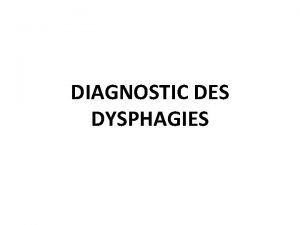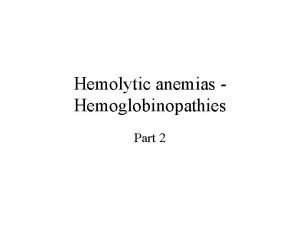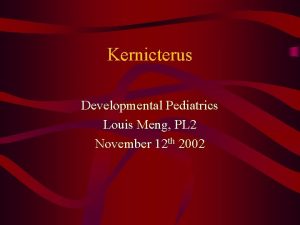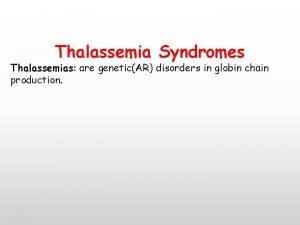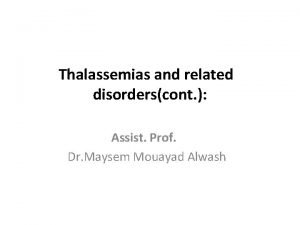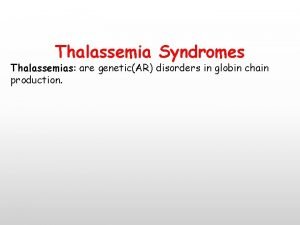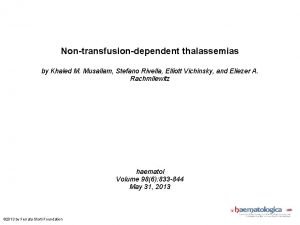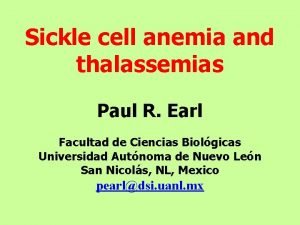The Thalassemias Louis Meng PL 2 PHO Elective


















- Slides: 18

The Thalassemias Louis Meng, PL 2 PHO Elective

Introduction • Heritable, hypochromic anemias-varying degrees of severity • Genetic defects result in decreased or absent production of m. RNA and globin chain synthesis • At least 100 distinct mutations • High incidence in Asia, Africa, Mideast, and Mediterrenean countries

Hemoglobin Review • Each complex consists of : – Four polypeptide chains, non-covalently bound – Four heme complexes with iron bound – Four O 2 binding sites


Globin Chains • Alpha Globin – 141 amino acids – Coded for on Chromosome 16 – Found in normal adult hemoglobin, A 1 and A 2 • Beta Globin – 146 amino acids – Coded for on Chromosome 11, found in Hgb A 1 • Delta Globin – Found in Hemoglobin A 2 --small amounts in all adults • Gamma Globin – Found in Fetal Hemoglobin • Zeta Globin – Found in embryonic hemoglobin

Hemoglobin Types • • Hemoglobin Type Globin Chains Hgb A 1— 92%----- a 2 b 2 Hgb A 2— 2. 5%---- a 2 d 2 Hgb F — <1%----- a 2 g 2 Hgb H --------- b 4 Bart’s Hgb------- g 4 glu val Hgb S---------- a 2 b 26 glu lys Hgb C---------- a 2 b 26

Genetics • Alpha globins are coded on chromosome 16 – Two genes on each chromosome – Four genes in each diploid cell – Gene deletions result in Alpha-Thalassemias • Also on chromosome 16 are Zeta globin genes— Gower’s hemoglobin (embryonic) • Beta globins are coded on chromosome 11 – One gene on each chromosome – Two genes in each diploid cell – Point mutations result in Beta-Thalassemias • Also on chromosome 11 are Delta (Hgb A 2) and Gamma (Hgb F) and Epsilon (Embryonic)


Alpha Thalassemias • Result from gene deletions • One deletion—Silent carrier; no clinical significance • Two deletions—a Thal trait; mild hypochromic microcytic anemia • Three deletions—Hgb H; variable severity, but less severe than Beta Thal Major • Four deletions—Bart’s Hgb; Hydrops Fetalis; In Utero or early neonatal death

Alpha Thalassemias • Usually no treatment indicated • 4 deletions incompatible with life • 3 or fewer deletions have only mild anemia

Beta Thalassemias • Result from Point Mutations on genes • Severity depends on where the hit(s) lie – b 0 -no b-globin synthesis; – b+ reduced synthesis • Disease results in an overproduction of aglobin chains, which precipitate in the cells and cause splenic sequestration of RBCs • Erythropoiesis increases, sometimes becomes extramedullary

b-Thal--Clinical • b-Thalassemia Minor – Minor point mutation – Minimal anemia; no treatment indicated • b-Thalassemia Intermedia – Homozygous minor point mutation or more severe heterozygote – Can be a spectrum; most often do not require chronic transfusions • b-Thalassemia Major-Cooley’s Anemia – Severe gene mutations – Need careful observation and intensive treatment

Beta Thalassemia Major • Reduced or nonexistent production of b-globin – Poor oxygen-carrying capacity of RBCs • Failure to thrive, poor brain development – Increased alpha globin production and precipitation • RBC precursors are destroyed within the marrow • Increased splenic destruction of dysfunctional RBCs – Anemia, jaundice, splenomegaly • Hyperplastic Bone Marrow – Ineffective erythropoiesis—RBC precursors destroyed • Poor bone growth, frontal bossing, bone pain – Increase in extramedullary erythropoiesis • Iron overload—increased absorption and transfusions – Endocrine disorders, Cardiomyopathy, Liver failure

b-Thalassemia Major—Lab findings • Hypochromic, microcytic anemia – Target Cells, nucleated RBCs, anisocytosis • Reticulocytosis • Hemoglobin electrophoresis shows – Increased Hgb A 2—delta globin production – Increased Hgb F—gamma globin production • Hyperbilirubinemia • LFT abnormalities (late finding) • TFT abnormalities, hyperglycemia (late endocrine findings)

b-Thalassemia Major--Treatment • Chronic Transfusion Therapy – Maximizes growth and development – Suppresses the patient’s own ineffective erythropoiesis and excessive dietary iron absorption – PRBC transfusions often monthly to maintain Hgb 10 -12 • Chelation Therapy – Binds free iron and reduces hemosiderin deposits – 8 -hour subcutaneous infusion of deferoxamine, 5 nights/week – Start after 1 year of chronic transfusions or ferritin>1000 ng/dl • Splenectomy--indications – Trasfusion requirements increase 50% in 6 mo – PRBCs per year >250 cc/kg – Severe leukopenia or thrombocytopenia

b-Thalassemia Major Complications and Emergencies • Sepsis—Encapsulated organisms – Strep Pneumo • Cardiomyopathy—presentation in CHF – Use diuretics, digoxin, and deferoxamine • Endocrinopathies—presentation in DKA – Take care during hydration so as not to precipitate CHF from fluid overload

Anticipatory Guidance and Follow Up • Immunizations—Hepatitis B, Pneumovax • Follow for signs of diabetes, hypothyroid, gonadotropin deficiency • Follow for signs of cardiomyopathy or CHF • Follow for signs of hepatic dysfunction • Osteoporosis prevention – Diet, exercise – Hormone supplementation – Osteoclast-inhibiting medications • Follow ferritin levels

On The Horizon • Oral Chelation Agents • Pharmacologically upregulating gamma globin synthesis, increasing Hgb F – Carries O 2 better than Hgb A 2 – Will help bind a globins and decrease precipitate • Bone Marrow transplant • Gene Therapy – Inserting healthy b genes into stem cells and transplanting
 Louis xvi louis vuitton
Louis xvi louis vuitton Ano ang nilalaman ng sanaysay
Ano ang nilalaman ng sanaysay Eogd examen
Eogd examen Music elective programme
Music elective programme Generic elective academic writing and composition
Generic elective academic writing and composition College preparatory elective examples
College preparatory elective examples Aberdeen electives
Aberdeen electives Elective ict
Elective ict Xiannong meng
Xiannong meng Weiyi meng
Weiyi meng Yu meng uu
Yu meng uu Uconn pmba curriculum
Uconn pmba curriculum Deyu meng
Deyu meng Breena meng
Breena meng Ucl computer science
Ucl computer science Uconn meng
Uconn meng Tuliskan pengertian salat dalam keadaan darurat
Tuliskan pengertian salat dalam keadaan darurat Dr meng huang
Dr meng huang Helen meng
Helen meng


